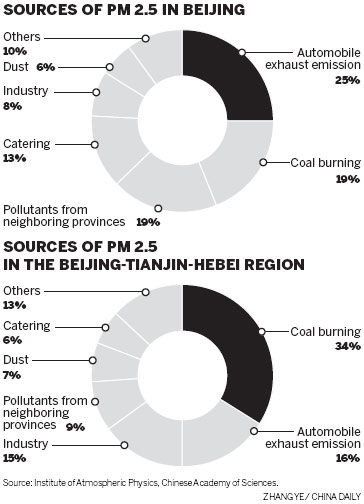The latest research from the Chinese Academy of Sciences found a large amount of nitrogen-containing organic compounds in the recent smog that shrouded Beijing and neighboring cities. The compounds are key components of the photochemical smog that shrouded Los Angeles during the 1940s and 1950s, causing hundreds of premature deaths and around 2,000 traffic accidents in a single day in 1954.
Exposure to nitrogen dioxide might damage the lungs and increase respiratory infections, especially in children and the elderly.
The nitrogen-containing organic compounds are mainly from exhausts and account for a large amount of the city’s PM2.5, it is said.

Pollutants in the Pearl River Delta are more dangerous than those choking the capital because they contain higher levels of hazardous nitrogenous organic compounds, according to an expert at the China Academy of Meteorological Sciences.
The volatile organic compounds were mainly emitted during the manufacture of shoes and cosmetics and were the main components of photochemical smog.
Researchers from the London School of Hygiene and Tropical Medicine established a clear link between exposure to PM2.5 pollutants and early death after following 154,000 patients in England and Wales who had been taken to hospital with heart attacks between 2004 and 2007. They followed the patients for more than three years after their release from hospital. Nearly 40,000 died in that period. If PM2.5 levels had been reduced to their natural background rate, they calculated the number of deaths would have fallen by 4,873, or 12%.
“We found that for every 10 microgrammes/m3 in PM2.5, there was a 20% increase in the death rate,” said the research.
About 30 times thinner than a human hair, PM2.5 particles have long been identified as a respiratory problem, as their size enables them to lodge deep in the lungs. The average PM2.5 level in Hong Kong is around 30 to 35 microgrammes/m3. The World Health Organization has set guidelines of a maximum of 10 microgram of PM2.5/m3 as an annual average exposure.
In Beijing last month, PM2.5 levels reached 993 microgrammes/m3, almost 40 times the WHO’s recommended safe limit of 25 microgram over a 24-hour period, triggering a public outcry.
If some people still underestimate the dangers of air pollution, they are really naïve.
Read more:
21 February 2013 – Smog in Pearl River Delta ‘worse than in Beijing’
http://www.scmp.com/news/china/article/1154950/smog-pearl-river-delta-worse-beijing
and this one, with a questionable title:
19 February 2013 – ‘Smog readings in Beijing nothing to be concerned about’
By Zheng Xin (China Daily)
http://usa.chinadaily.com.cn/epaper/2013-02/19/content_16236264.htm